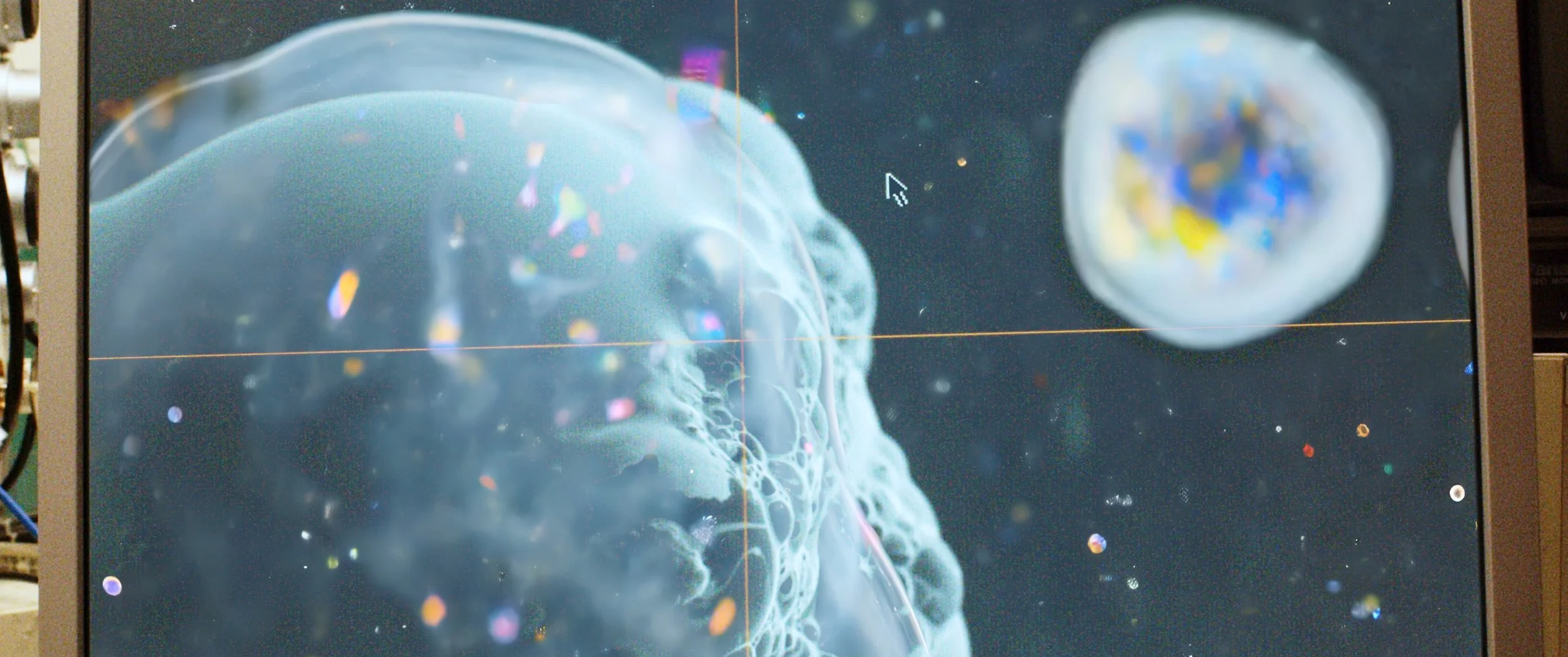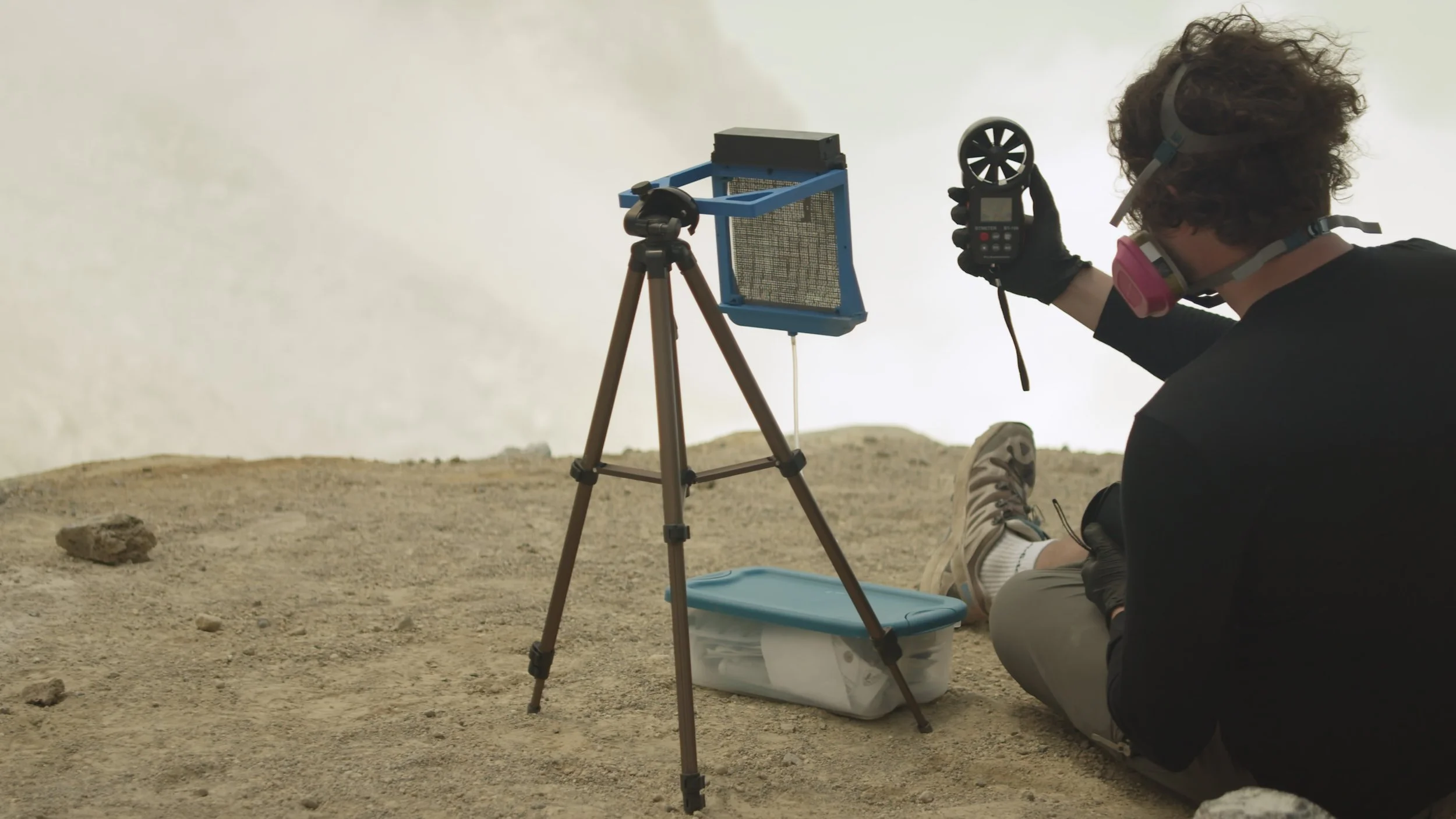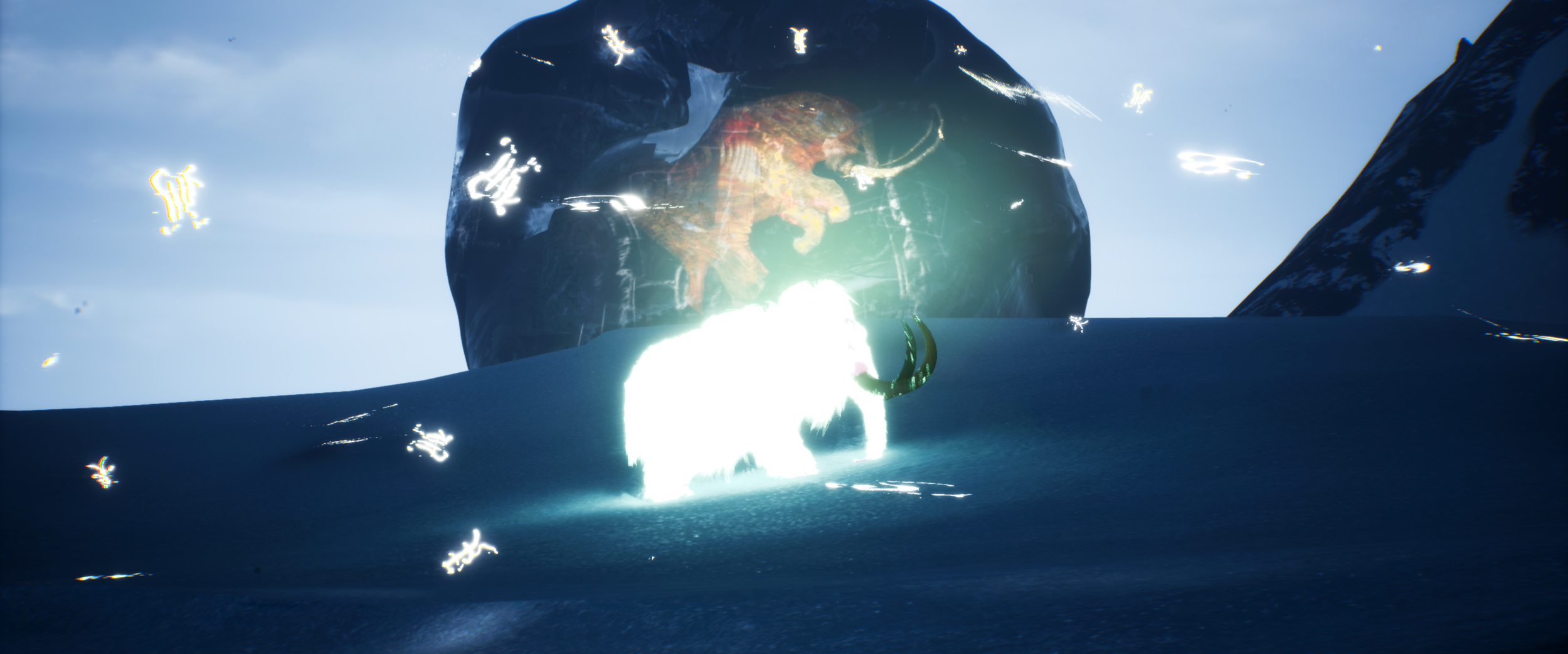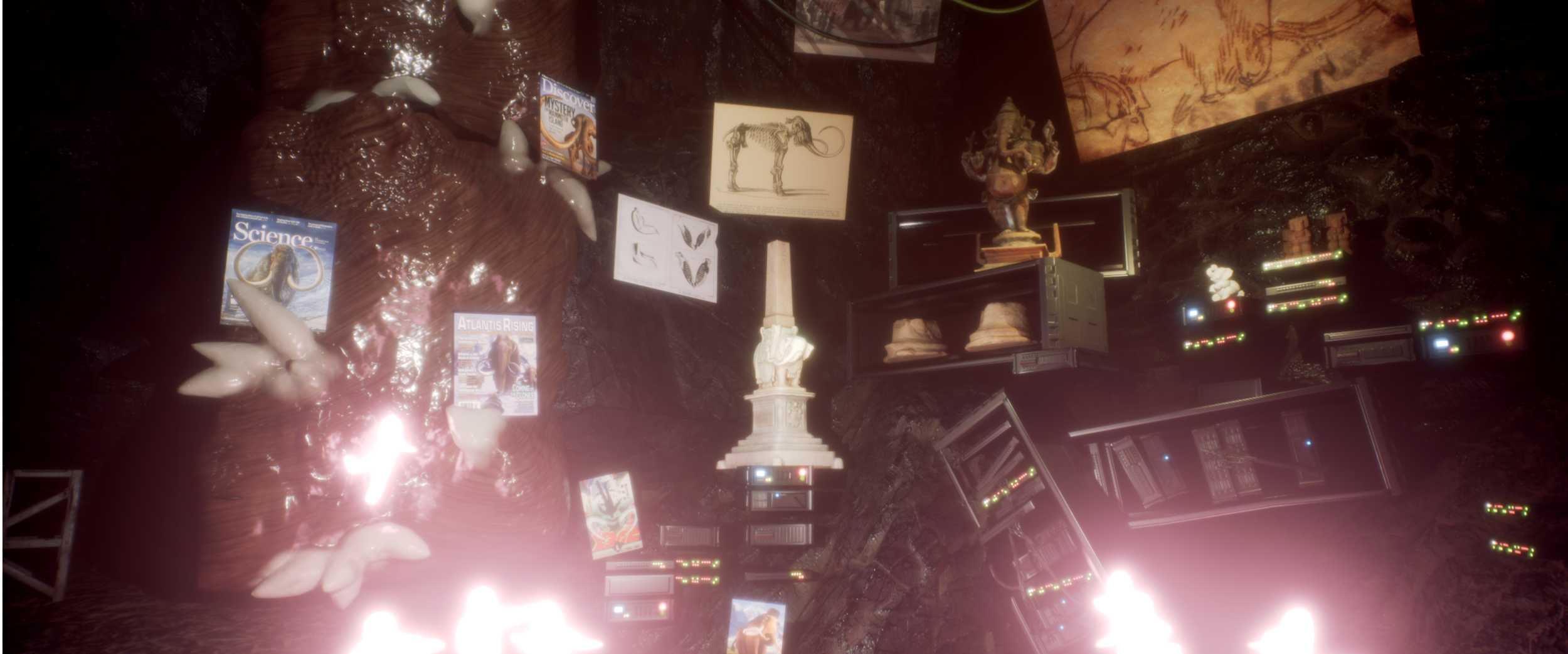WENDI YAN
Portrait, courtesy of the artist.
Wendi Yan (b. 1999, Beijing) constructs speculative epistemologies through research-based worldbuilding, using CGI, game engines and documentary practices to interrogate the boundaries of scientific imagination. Her work—spanning films, interactive media, and fictional archival installations—examines the embodied challenges of facing alien epistemic systems across time. She has been commissioned by the Berggruen Institute, and her work has or will be presented at HEK (Basel), Hyundai Motorstudio (Beijing), Slash (San Francisco), FWB Fest and Ars Electronica Festival. Wendi holds an A.B. in History of Science from Princeton University and a M.S. in Fiction and Entertainment from SCI-Arc. She was an inaugural member of the Steve Jobs Archive Fellowship (2023), created by Laurene Powell Jobs to support young creators between technology and liberal arts. In 2025, Wendi won the Grand Prix of the 6th VH Award by Hyundai Motor Group, Asia’s leading media art award.
LUCIJA ŠUTEJ: In Visions of Phosphine Earth, you collaborated with MIT scientists to create a fictional planet. The work combines various methodologies, including both hard and speculative/fabricated data. Could you share with us the research behind the work, working with Dr. Iaro Iakubivskyi?
WENDI YAN: I have always been interested in the interplay between fiction and science, both in the public realm and within the lab. This project began with the visionary research by Dr. Sara Seager's team at MIT, investigating the possibility of microscopic life in Venus's clouds.
A focal point of Dr. Seager's research is looking at phosphine as a biosignature gas. This led her team to the Ijen lake in Indonesia, which contains a really high concentration of sulfur (the Ijen volcano is one of the two in the world with electric blue lava). Dr. Seager's team gathered samples from this region to study its composition: it's highly toxic for us, but does not have to be for life elsewhere. Discoveries to date reveal that some of the nucleic acid bases are stable in concentrated sulfuric acid, and they are working towards an alternate DNA, swapping out parts to find an informational polymer that would be stable in the before mentioned acid. If successful it would be a compelling case of missions to Venus, where the surrounding clouds could have life using concentrated sulfuric acid as a solvent.
The fictional planet "Phainoterra" was conceived by scientists as a speculative exercise in imagining alien life in Venus's clouds. Collaborating with Dr. Iaroslav Iakubivskyi and Dr. Seager, my film explores the visual and metaphysical imaginings of this pink planet harboring life in its sulphuric clouds.
Stills of Phainoterra. Images courtesy of the artist.
Phainoterra AI.
I used Dr. Iaroslav's footage from his expedition to Indonesia's Ijen volcanic lake and MIT lab experiments, weaving them with my 3D animations created in Unreal Engine. I built virtual environments for Phainoterra based on their research, including planetary views, cloud formations, and landscape models with animated acidic pools. I also took Scanning Electron Microscope images of soil samples from their expedition and used AI to generate speculative microbial activities on top of these images, to speculate the life forms we might find on Venus one day. Within the SEM, a feral universe emerges between scientific imaging and imagination.
Dr. Seager and Dr. Iakubivskyi's knowledge-making process constantly moves between planes of reality, representing what I see as a profound act of epistemic courage in imagining life beyond Earth-conditioned comprehension. I emphasized that through my blending of expedition footage and sci-fi animation, scientific imaging with speculative forms.
Wendi Yan, cinematography credits Iaroslav Iakubivskyi.
LŠ: AI is blurring the distance between fact and storytelling, as you demonstrated through your work - how do you see the role of artists in challenging the narratives?
WY: In our own lives, our narratives about ourselves are never truly factual but often partially aspirational. In my academic training in history, I strove for factual accuracy but knew that what I wrote was also a narrative with my subjectivity embedded in it. As an artist, I don’t fear the increasing blurriness between facts and fiction driven by AI so much as I fear that we lose awareness of how narratives shape our realities. Those with power are always promoting narratives that legitimize and strengthen their power. So I, as a marginal individual, use my imagination (rooted in research) to free myself from the narratives that try to control me toward ends I don’t believe in.
LŠ: In your earlier work Mammoth Goddess there is the presence of an AI-generated sound- perhaps you could for the audience share the story of the work?
WY: Back in 2022, I heard about scientists resurrecting woolly mammoths, and I wondered how a resurrected mammoth would feel growing up. I read a book on the cultural history of mammoths (The Fate of the Mammoth by Claudine Cohen) and spent a year imagining the subjective experience of the world’s first resurrected mammoth. I decided to let my imagined character know everything about how she comes about: what emotions would she have toward humans?
AI voiceover was a natural choice, as the resurrected mammoth would also be a hybrid entity between natural and artificial: an Asian elephant with a few dozen woolly mammoth genes edited in, she is effectively a new species of her own that was born to imitate and perform a megafauna long gone. In the film, I wanted her voice to sound gimmicky, circling the edge of the uncanny valley. Her voice would change from a young valley girl accent to an older European accent, to, in a few moments, multiple voices with different pitches at once. I imagined her to have a loose selfhood. She is inherently fractured between time, space, and species; she has multiple selves.
I used this mammoth’s subjectivity as my vantage point for viewing human history. At a time full of alarms over our species’ self-destruction—yet nothing seems to be steering us out of the doomsday direction—could another creature, both manmade and prehistoric, prism uniquely the catastrophic web of complexity we have caught ourselves in? That was the core of my exercise in Tale of the Mammoth Goddess.
Stills of Mammoth Goddess. Images courtesy Wendi Yan.
LŠ: Are there other animals and non-humans which you are currently researching?
WY: I have been thinking about the term "Artificial Intelligence" in itself: how gimmicky it is, and how misled I feel by those touting its arrival. Whatever we call AI today is just not intelligence to me, and when tech CEOs use the term, I just feel they are knowingly evoking an exotic imagination that is incredibly powerful at mobilizing capital.
It appears very similar in essence to the debates about life and intelligence in the 18th century when Europeans built automata: a duck, a human, or something else, they were always just an intricate combination of mechanical skills and magic tricks. And yet they provoked lively debates around intelligence. Everybody is talking about AI today, but maybe a century later people will look back on our time the same way we look back on 18th century devices.
LŠ: In relation to the work, it would be relevant to state that AI is not just altering how we experience the present but also how we will navigate the future. As well as how we see, learn, and remember history. How do you see the relationship between memory and AI?
WY: Before the incredible progress of AI, I was already fearing that we would not have any good history to write about in the future because the internet doesn’t actually remember. I lost my childhood blog when the platform shut its service down, for example. I might have exported it as an insufferable .txt file somewhere as a backup, but that would never be the same: I embedded codes I never fully understood and decorated my blog page maximally with cartoony interactive modules.
The LLM-powered form of AI hallucinates, and it’s the most beautiful and tortuous feature. I love being inspired by its false memories and misinterpretations (or shall I say, mispredictions of the next plausible words). Yet I also fear that it will further accelerate and magnify how we forget. These days, I already find myself offloading bundles of previous thoughts and writings to one conversational thread with AI, hoping it’d remember and digest for me. But that’s probably dangerous for my own memory health. I have to be cautious to catch AI recalling falsely at any moment, which defeats my original purpose.
LŠ: Further with the rise of AI, algorithms are flattening and shaping data. Your work Eternal Revolutions of Techne, presents the motif of Three Hares and I first wanted to stop at your research into how the Three Hares have travelled across different cultures and how their symbol and meaning altered?
WY: The symbol of three hares chasing each other in a circle with overlapping ears has a name in Chinese. The earliest record of Three Hares is in the Mogao caves in Dunhuang, which dates back to the 7th century, and is an important point of the Silk Road. But the same symbol, with different artistic renderings, has been found in Mongol metalworks, Iranian brass trays, Islamic glassware, synagogue ceilings as well as English churches. You can almost trace a directional line here that begins from the East and went westward to England over several centuries. Chris Chapman has a website for his Three Hares project.
In the context of memory and technology here, Three Hares is a powerful example of something that persists despite geographical and material barriers. Its semantic readings shapeshift across regional contexts, but any artifact bearing this symbol is likely intended to invoke concepts of eternity and vitality.
To me, it provides a compelling case of how “mistranslations” can produce beautiful results. I guess there is a similar process involved here at the cultural scale in a pre-modern age as an LLM. Transferring from one culture to another, and moving geographically too, Three Hares took on a life of its own that withstood time.
The Three Hares, research.
LŠ: You mentioned you are interested in exploring the transferring from one culture to the next. Are there specifics?
WY: In a different dimension, perhaps! I have been looking at how Daoist cosmological ideas were historically (mis)translated, (mis)interpreted, and adapted in the West. Those stories are always so fascinating, because you kind of realize that conceptual cross-pollination always happens more frequently and earlier than you'd imagine. It's something that's so integral to human civilization, and no concept gives birth to itself.
One example is "laissez-faire," which directly came from Daoist concept of "wuwei". The French economist François Quesnay wrote about Chinese knowledge, and coined this term, which then got popularized by another economist, Vincent de Gournay. That a concept we associate with "Western liberalism" actually came from an 18th century imagination of the Chinese economy, is so fascinating to me.
LŠ: Why did you find diptych (in video format) as the ultimate vessel to transfer the work?
WY: Comparison gives rise to new thoughts. I’m always thinking in between polarities I define to work out my creative decisions. These dialectical axes typically encompass temporality (future vs. past), epistemic medium (science vs. fiction), and representational modes (visual logics vs. textual narratives). Each small decision I make in my work is weighed intuitively along these axes in my mind.
The form of the diptych is a playground for me to decide on the two polarities for my audience to travel between. In the case of Three Hares, the left “panel” imagines a breathing Dunhuang cave surface, foregrounding three hares springing forth from an undulating rock lotus. The right “panel” assumes an unspecific future, the three hares have leaped out of the Cave of the Thousand Buddhas, and become a mechanical instrument formally inspired by quantum computers, revolving as a machine of perpetual motion.
Diptych, The Three Hares.
LŠ: What are we losing through AI?
WY: AI tricks us into thinking we have thought something—that concerns me the most. Whether generating images, videos, or texts, AI tools are so smooth at giving us results we thought we wanted that we forget to ask ourselves: is this where I would have landed if I had tried to paint the image, make the video, or write the text myself? Thanks to AI, we get a surface experience of producing results, and it can feel satisfying, even addictive, but we haven’t done the thinking that would have been the most rewarding part of the whole process. This underpins all of my interactions with AI. I am always vigilant about the provenance of thoughts.
LŠ: In your other interviews and through your work you touched upon the idea of ahistorical - as a way to describe the present times. Could you elaborate? History is biased - with AI are we disrupting the narrative or accelerating it?
WY: The internet architecture is prone to forgetting. More than ever, the media environment provokes our sensations, but also demands us to forget the context of the previous piece of content, every second. We are commanded to believe in every direction, so we all think we are too good to fully believe in any of them.
I often get asked about why I make fiction inspired by history: am I doing the work of a historian, or what am I doing? It’s true that we are not in short supply of misinformation. It almost feels impossible to excavate the truths of any event today. AI is certainly going to make this order of magnitude worse. So many people talk to AI chatbots and take what they say as authoritative truths (or something “true enough” for their purpose), while AI is always hallucinating, making up names that never existed. Daniel Mark Thomas McQuillan wrote that AI—in their LLM-powered form today—operates in a conspiratorial manner. I find that view compelling.
Truth to me is not a bundle of pure material substance I hold in my chest. I care more about the vector force of aspiration that pulls people together. Each of us organizes our “self” through a series of self-authored fictions, which are a mix of memories and aspirations. They are never quite fully true, but does that matter? Aspirational fictions shape reality. So I try to use technology, especially AI, to help me make more of them in my art practice.











